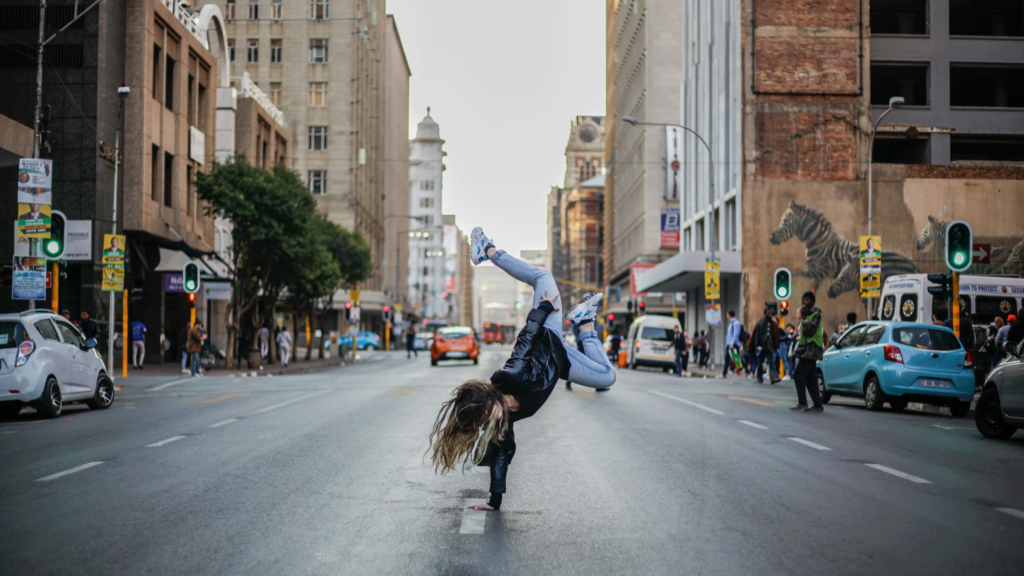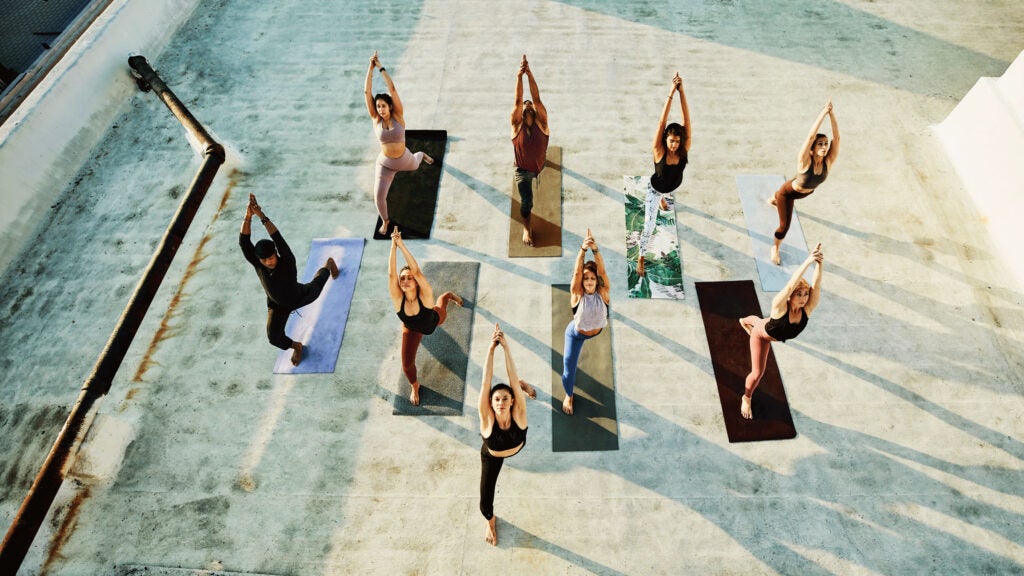Key Takeaway
Discover 7 effective yoga poses designed to enhance balance specifically for seniors.
Did you know that one in four older persons fall annually, according to the CDC? But don’t worry, when it comes to helping elders become more stable and balanced, yoga can be a game-changer. We’ll look at 7 amazing yoga poses in this post that will help you keep balanced and lower your chance of falling.
7 Best Yoga Poses for Balance for Seniors
1. Mountain Pose (Tadasana)
If you are looking to strengthen your balance, the mountain pose, also known as Tadasana, is an excellent place to start. It’s an easy standing pose for your core and legs.
Place your feet hip-width apart to begin. Ensure that your feet are bearing the same amount of your weight. Lift your knees a little and engage your thighs. To make your spine appear longer, tuck your tailbone beneath. Pull your shoulders downward and back. Inhale deeply and raise your arms above your head, palms facing each other. Release your breath and lower your arms again. Do this five to ten times over.
I adore the anchoring sensation of Tadasana. It’s the ideal approach for me to center myself and begin a yoga practice. Seniors who need support can grab onto a chair. You become more concentrated and aware in this stance. If you struggle with balance, place your feet hip-width apart and lean on a chair or wall for assistance. Recall that consistency is the key to winning!
2. Chair Pose (Utkatasana)
Utkatasana, or Chair pose, is an excellent yoga practice. It strengthens your legs and aids with balance. Place your feet hip-width apart to begin. Begin as if you were seated in a chair hover a few inches above the seat.. Maintain a straight back while you drop your seat and bend your knees. Lift your arms above your head so that your palms face one another. Hold for 5-10 breaths.
I still recall my initial attempt at Utkatasana. I believed that I couldn’t possibly hold it! In a matter of seconds, my thighs began to burn. However, it became one of my favorites with practice. It tests your balance while toning your glutes and legs. If you require further assistance, position a chair behind you or place the chair in front of you and hold on for balance. You can also maintain your arms by your sides or bend your knees less. Just keep your head forward and your chest raised!
3. Tree Pose (Vrksasana)
Vrksasana, often known as Tree Pose, is a traditional balancing pose that is ideal for elders. Put your left foot on your right ankle, calf, or inner thigh while you shift your weight to your right foot. Keep it from resting directly on your knee. Lift your arms upward in the Namaskar Mudra, where you join both of your palms in front of your chest. After holding for five to ten breaths, swap sides.
At first, it appears hard to balance on one leg! But you can do it with ease if you have a wall for support. This pose makes the standing leg stronger and tests concentration. Start by putting your foot on your calf or ankle if you’re a beginner. You can raise it higher as you get more at ease.
4. Warrior III (Virabhadrasana III)
Virabhadrasana III, also known as Warrior III, is a dynamic balancing position that tones your legs and core. Place your feet hip-width apart to begin. Raise your left leg behind you and shift your weight to your right foot. Maintain a square hip position. With your arms extended ahead and your left leg extended behind you, bend forward from your hips. After holding for five to ten breaths, swap sides.
Warrior III appears sophisticated! But one can learn to balance with the aid of a wall. If you’re not familiar with the stance, use a chair or wall as support. Try raising your arms above your head or lifting your leg higher as you gain strength. Just maintain a flat back and an engaged core. If you initially need to touch down with your hands or lower your leg, that’s alright. You’ll master Warrior III with practice!
5. Balancing Star Pose
For Star Pose, place your feet hip-width apart to begin. Elevate your left leg to the side and shift your weight into your right foot. Maintain a square hip position. Raise your arms shoulder-high and out to the sides. After holding for five to ten breaths, swap sides.
This is an excellent method to test your coordination and balance. If you’re not familiar with the stance, get support from a chair or wall. Try extending your leg higher or raising your arms above your head as you get more at ease. Simply maintain an engaged core and a focused gaze.
6. Knee to Chest Pose
A fantastic technique for strengthening your legs and core while also increasing your balance is Knee-to-Chest pose. You may raise your right leg towards your chest. Keeping your back straight, reach your arms forward and interlace your fingers around the front of the shin. After holding for five to ten breaths, swap sides.
If you’re not familiar in holding this pose, get support from a chair or wall. Try raising your knee and extending your arms as soon as you are comfortable.
7. Bridge Pose (Setu Bandhasana)
Bridge Pose, also known as Setu Bandhasana, is a backbend that enhances balance while strengthening your hamstrings, glutes, and back. To begin, lay on your back with your feet hip-width apart and your knees bent. Firmly plant your feet and arms on the ground, then raise your hips. Draw a straight line connecting your shoulders to your knees. Hold for ten to fifteen breaths, then release.
This pose is a fantastic method to improve your back and leg strength while testing your balance. Put a folded blanket beneath your shoulders for support if you have problems with your neck or shoulders. To work your inner thighs, you can also put a block between your thighs. Try stretching your legs or interlacing your fingers together underneath yourself once you’re comfortable in the position. Maintain a tight core and move slowly. Just go as far as feels nice and pay attention to your body!
See Also: The 9 Best Types of Yoga for Seniors
Why Yoga Poses for Balance for Seniors?
Enhanced synchronization and stability
Heightened muscular strength in the lower body
Heightened proprioception and awareness of the body
Low-impact workouts appropriate for different levels of fitness
Decreased tension and improved mental clarity
Safety First: Preparing for Your Yoga Practice
Consult your physician before beginning any new fitness regimen, especially if you have existing health conditions or concerns.
Locate a certified yoga teacher with experience instructing senior citizens.
For support, use furniture such as walls, chairs, and blocks.
Pay attention to your body and avoid overexerting yourself.
Conclusion
You’ve just learned 7 incredible yoga poses that will help you become more stable and balanced. By adding these easy, low-impact workouts into your daily regimen, you’ll be well on your way to being a more confident, steadier version of yourself. It’s never too late to begin practicing yoga, and there are many advantages beyond enhanced physical health. Why not attempt it, then? Spread out your mat, inhale deeply, and move towards a future with greater equilibrium.
Namaste!
Pop quiz! 🧘🤔
Practicing yoga can help improve balance and stability in seniors.
YesNo
Seniors should avoid balancing poses in yoga as they can lead to falls and injuries.
YesNo
Tree Pose is a yoga pose that can enhance balance in seniors.
YesNo
FAQs
1. How can seniors safely practice yoga to prevent falls?
Seniors can safely practice yoga by ensuring they are in a comfortable environment and using props as needed. It is important to consult with your doctor before starting any new exercise regimen, especially for those with existing health issues. Practicing under the guidance of a qualified yoga instructor can also help. Modifications for each pose should be considered, such as using a chair for support or practicing against a wall. Focusing on breath control and maintaining a steady gaze can also enhance stability and reduce the likelihood of losing balance.
2. What should seniors keep in mind about their breathing during yoga?
Breathing is an essential aspect of yoga, particularly for seniors. Practitioners should focus on deep and controlled breathing, using techniques such as pranayama. Inhale deeply through the nose and exhale slowly through the
Thanks for your feedback!







